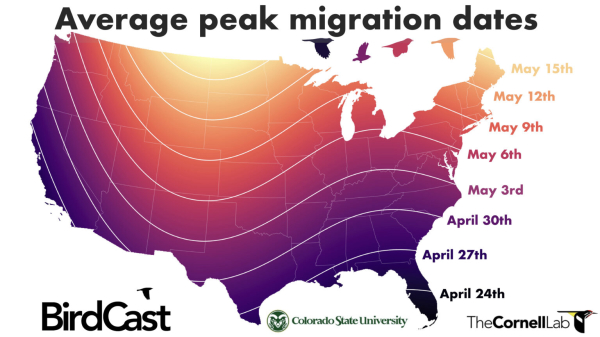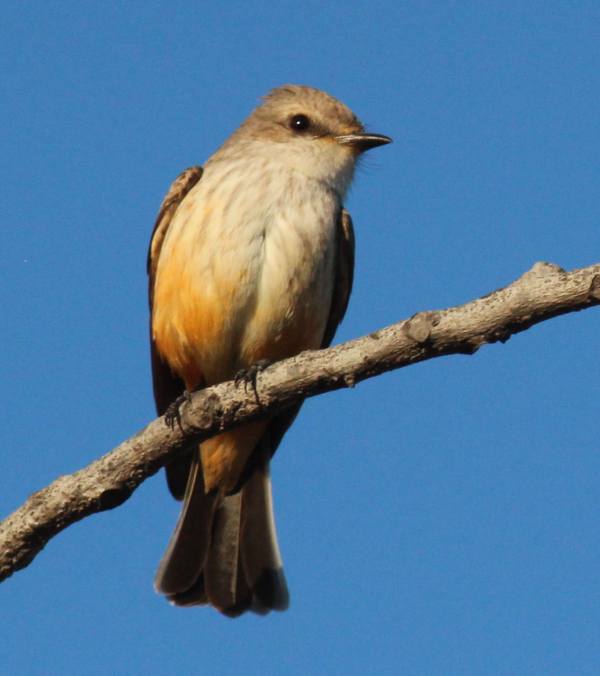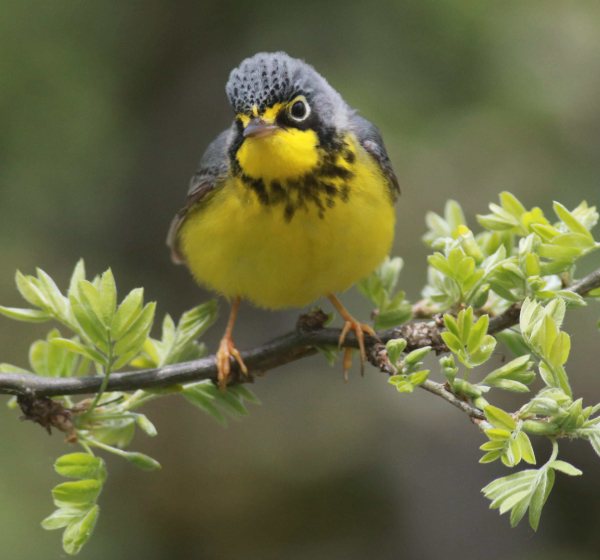 An exceptionally handy map that shows the progress of peak songbird migration across the continental United States is provided by BirdCast.  Along with the songbirds we look forward to, you may see a rarer bird like a Vermillion Flycatcher if you are in the American Southwest (photos by Paul Konrad).  What birds will suddenly appear in your yard this spring? Warbler migration will begin in earnest in the next week and continue through late May in some areas. Will you see a Canada Warbler this year? |
Spring is the time of year when we get most excited with each new species that appears before us, in our yard, our neighborhood, at work, area parks, and in the great outdoors beyond urban and suburban settings. What new birds showed up at your feeders and in your trees this week? We birders tend to be record keepers, at a variety of levels. Many of us get most excited about how many species we can see from within their property lines. Some people’s birding interests are fueled by adding new species to their yard list, their annual list, their life list – you know how it goes.
Each spring, there are always a few standout birds that we will never forget – and each of them is realistically worth writing a short story about. Of course, “a picture is worth a thousand words,” so if you get a photo of the new bird, or if you can draw or paint a picture, that will make your story all the more interesting. Then what? Share your story and illustration(s) with family members and friends, fellow birders, anyone you wish – via text, email, social media – you pick the media.
Many birders are already into record-keeping and citizen science via their eBird posts and Project FeederWatch efforts. If you aren’t among them, do look into these important and enjoyable ways to make your backyard birding all the more interesting. What good are these records? First they are personally fulfilling, but they are also useful next spring and during future springs when you are wondering what birds to look out for on a week to week basis.
Ultimately, aren’t we all wondering what to expect next? What birds are on their way northbound as migration progresses weekly? We wanna know! These days we are so lucky to have access to some really high-tech, ultra-interesting opportunities available online. Here, we will provide an introduction for you to get to know the migration monitoring opportunities offered at 3 premier birding websites: eBird, Birding News, and BirdCast.
Monitor eBird Hotspot Sightings
If you aren’t familiar with eBird yet, or if you don’t use eBird in this way, you can find any “Hotspot” location by zooming in on the area where you live, looking for a red hotspot pointer some distance south of your home – say 1 or 2 states to the south, and see what birds are being reported there recently, which will give you some impression of what birds are showing up there, and what you might expect to see in coming days.
To give this a try, see Explore Hotspots - eBird where you can zoom in on the map to a location you have in mind until the small yellow, orange, and red boxes turn to “pointers.” Click on a red pointer near an area that interests you, and a small white box will pop up. Scroll within the white box that has the name of the hotspot at the top, and click on the blue box titled “View Details.” A page will open with a list of 5 birds, but to see all species click on the blue button titled “Show all sightings” positioned after the 5th bird species listed; then scroll to see what birds have been reported recently. Check out a few red pointer locations a state to the south of your home, and other red pointers a few states to the south, and you should find results that reveal some birds that will soon arrive at your home range.
We also like to keep aware of what’s happening on a grand scale as spring migration progresses. To do this, we monitor 2 primo hotspots that act as gateways where neotropical migrants arrive in the United States (High Island, Texas) and pass into Canada (Magee Marsh, Ohio). You can access the latest eBird lists for these hotspots at High Island--Boy Scout Woods (UTC 055), Galveston County, TX, US - eBird Hotspot and Magee Marsh--Boardwalk, Lucas County, OH, US - eBird Hotspot To date, the very first neotropical migrants are showing up at these 2 hotspots – some warblers, thrushes, tanagers, orioles, and others – but keep checking in and you will be duly impressed with how numbers of birds reported and species diversity changes the last week of April (just a week away!) thru the 3rd week of May!
Birding News, State by State
The American Birding Association’s excellent website, “Birding News” is the ABA’s longtime social media option that was something of a forerunner to eBird, but some state venues still provide valuable updates that you really can’t obtain elsewhere on such a person by person level. When you open the website at Birding News brought to you by American Birding Association - (aba.org) simply scroll down and click on the box under the heading “State/Province” to access the list of states and provinces. Pick the state that interests you, and the list of messages shared by birders will appear, and some messages should have information that will reveal migrating bird species being seen in areas of that state.
In addition to checking on messages for your state, check on state sites south of your home to see what information other birders are sharing about the birds they are seeing. Depending on your position, check on Texas, southern California, and Florida for starters, then explore a bit from there to see what migrating birds people are seeing that will help clue you into what to expect in your neck of the woods.
Migration Dashboard
Maybe the best information source about “what birds to expect next” is BirdCast’s insightful website, Migration Dashboard, which provides localized bird migration information for any county in the continental United States at Migration Dashboard - BirdCast. Just type the name of your county into the white box at the top of the Migration Dashboard webpage to see daily updates on local bird migration that provide an illustrated list of some of the birds you can expect to see next in your area. You can also explore bird migration progress in other states and counties of interest across the Lower 48 States to get a feel for what birds are headed your way.
While you are at it, BirdCast webpages can help us better understand and follow the nightly progress of bird migration north this spring. You can access the live radar-based migration map at Live bird migration maps - BirdCast Although this website doesn’t provide species-specific information, it does give you an understanding of how migration progresses day by day, even offering some migration forecasting with Bird Migration Forecast Maps at BirdCast - Bird migration forecasts in real-time We hope you enjoy referring to these cutting edge bird migration resources regularly!
Learning More About the Birds We See
Birding isn’t merely about seeing a bird, or even photographing it; it’s about learning more about the birds we see, and that’s where “All About Birds” comes into play. All About Birds is a website provided by who else but the Cornell Lab of Ornithology, the leaders in bird study and the dissemination of information about birds. After accessing the website at Search, All About Birds, Cornell Lab of Ornithology you just type in the name of the bird in question to get some introductory information about that species. Of course, there are many excellent books available too, some of which you may have in your personal library, or you can access books at your public library or a nearby college library.
If you really want to “know it all,” the ultimate information source about any birds that will ever grace your yard or that you will see anywhere else, is the Birds of the World website at Birds of the World - Cornell Lab of Ornithology Although this valuable resource has a subscription price, it’s easy to try it for a month to see what a remarkable source of information it is (it’s just $8 per month, or $49 per year). You will enjoy learning from this resource, seeing the photographs, illustrations, videos, and song recordings – and we believe all birders should use Birds of the World. It’s our best and most indispensable access to information about all birds provided in one location – and you can access it anytime online, at home or wherever you are.
Sometimes we may think of backyard birding as a relatively simple activity, but it’s really as involved as you want it to be, and as rewarding as you make it. Certainly there are many ways to enjoy birds in our yards and beyond, and record keeping and migration monitoring are some interesting aspects of birding that we can all use to expand our understanding of how our little corner of the world fits into the bigger nature of things. Enjoy your yard and the birds that visit it this spring to the fullest, and enjoy an exceptional spring migration!
Share your backyard birding experiences and photographs with The Birding Wire at editorstbw2@gmail.com
